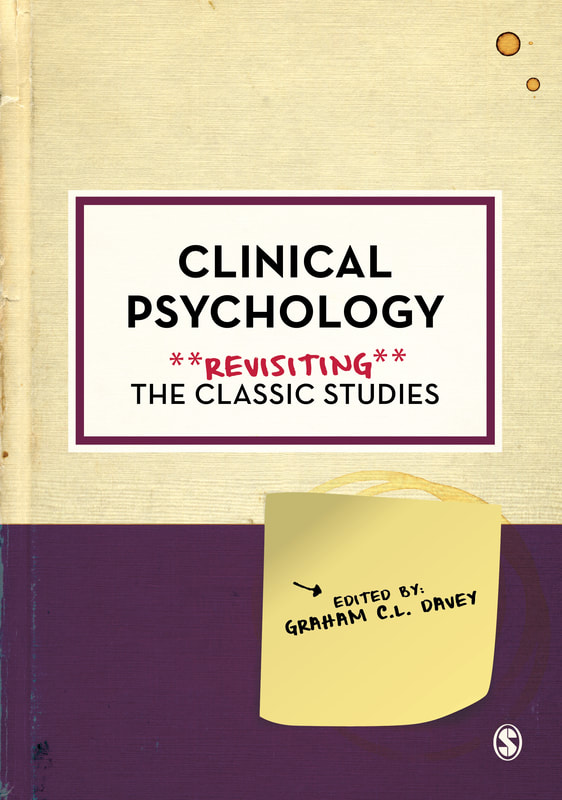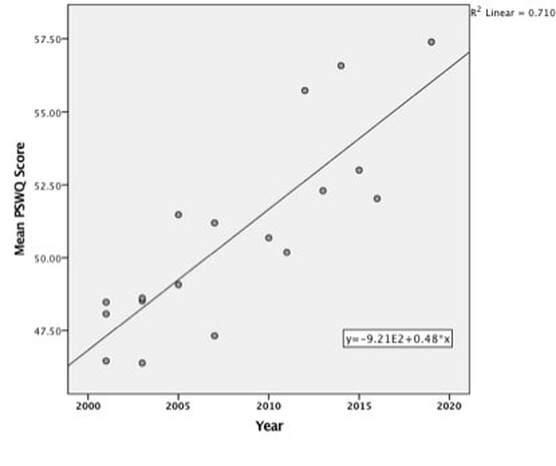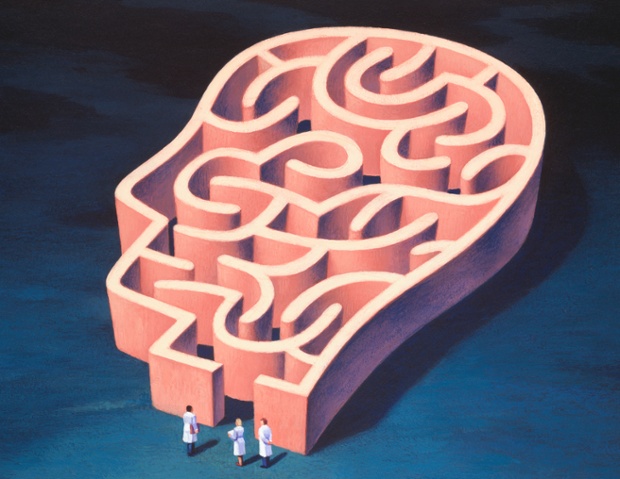Choosing the “classic” studies to critique in a book like this is difficult, so before I drew up a final list of influential studies I used Twitter to ask the clinical psychology community their views on what they considered should be in a list of classic studies. Those views have significantly influenced the final list, and chapters cover studies that have shaped modern day conceptions of diagnosis and assessment, contributed to our current understanding of aetiology across a range of different mental health problems, and led to developments in contemporary therapeutic practice. In this book, we’re privileged to have contributors who are international experts providing their detailed critiques of these classic studies and giving their informed opinions on the ways in which each study has influenced modern day clinical psychology and clinical practice.
A number of these classic studies were controversial at the time they were published, and are still controversial today. For example, Chapter 1 - written by Richard Bentall - covers one such study, namely David Rosenhan’s 1973 study entitled “On Being Sane in Insane Places”. This imaginative and provocative study claimed to show that psychiatrists at the time were unable to distinguish between symptoms of severe mental illness and ‘normal behaviour’. While many aspects of this study and its conclusions have been criticized over subsequent years, it undoubtedly influenced the following four decades of discussion about what exactly constitutes a “mental illness”, and has certainly contributed to ongoing debates between psychiatry and clinical psychology on the role of diagnosis in mental health provision (e.g. Bentall, 2017).
Almost every undergraduate psychology student will have come across the “Little Albert” study published by behaviourist John B Watson and colleague Rosalie Rayner in 1920. This was Watson’s attempt to demonstrate that basic conditioning processes could generate simple emotional reactions such as fear and anxiety, and in Chapter 2 we explore this textbook classic and its contribution to clinical psychology. The chapter authors Dirk Hermans, Yannick Boddez and Bram Vervilet ask “What would a parallel universe look like in which the romantically linked Watson and Rayner had never met?” Well, it’s very plausible that modern day treatments for anxiety would not be exposure-based and behaviour focused. We might all be practicing psychoanalysis today were it not for Watson’s inspired desire to show that a clinical application of empirically-validated principles of conditioning was possible.
Undoubtedly, one of the most significant influences on modern day clinical psychology practice has been Aaron Beck, arguably one of the founding fathers of modern day cognitive behaviour therapy (CBT). So for that reason, we’ve included two articles authored by Beck, one on the origins of cognitive therapy (Beck, 1964), and one discussing his influential cognitive model of depression (Beck, 1987). In Chapter 3 Adrian Whittington discusses Beck’s 1964 paper, a paper that was arguably a first step that has eventually led to millions of people having access to short-term, effective psychotherapy for common mental health problems such as anxiety and depression – psychotherapy provided through initiatives such as the improving access to psychological therapies (IAPT) programme pioneered in the UK by David Clark and colleagues (Clark, 2011). In Chapter 5 Clara Strauss covers Beck’s influential 1987 paper outlining in detail his cognitive model of depression. Beck developed his theory of depression from the observation of clients in his clinical practice. It was a theory that had cognitive psychological processes at its core in the shape of cognitive biases that could not easily be explained either by the biomedical psychiatric theories of the time or the psychoanalytic theory in which Beck had originally trained. In this sense, Beck was truly groundbreaking, creating an approach to mental health problems that was arguably defining a new paradigm incorporating explanation and treatment – an observational, pragmatic and evidence-based approach embracing empirically testable psychological processes and called cognitive therapy.
One of the challenges in the development of a science of mental health is the isolation and identification of individual conditions. Discovering commonalities in symptoms and disabilities across different individuals suffering mental health problems suggests that there may be a single set of underlying causes for these clusters of features. At a time when child psychology and child psychiatry were only just emerging as coherent disciplines, an Austrian named Leo Kanner published the first English language textbook on child psychiatry in 1935, and in 1943 went on to publish a landmark paper that has helped to identify and define the developmental disability now known as autism spectrum disorder (ASD). In Chapter 4, David Mason, Victoria Grahame and Jacqui Rodgers describe how Kanner was ahead of his time in rather accurately defining a collection of behaviours that have since become the foundation of our understanding of autism. He insightfully described autism as an ‘innate’ disorder, and even today our diagnostic criteria for ASD still reflect many of Kanner’s original observations about difficulties with social communication and the presence of restricted and repetitive patterns of behaviour.
Some classic studies gain their ‘classic’ status because they spark controversy and debate that remain unresolved to the present day. Such is the topic of “repressed memories” - the view that experiences of trauma can be ‘repressed’ or ‘forgotten’ and may be recalled later in life. Repression is a psychological process originally proposed by Freud in which negative feelings of shame, embarrassment or the like could lead to the loss of memory for an event – especially traumatic events occurring in childhood, such as childhood sexual assault, physical assault or even childhood neglect. It was in the 1990s that some individuals were coming forward claiming that they had been sexually abused in childhood but then had forgotten about it for many years. It was almost by coincidence that a study by sociologist Linda Meyer Williams was published around the same time. In her study she investigated whether adults known to have experienced childhood sexual assault remembered the incident or had forgotten it (Williams, 1994) – many it seems had forgotten it, even though hospital forensic records suggested they had been subjected to sexual assault. In the following decades, an intense debate known as “The Memory Wars” ensued (e.g. Goodman et al., 2003), with clinicians taking sides that either supported the view of repressed memories or in other cases claiming that recovered memories were in fact merely “false memories” implanted by various authorities, including therapists. In Chapter 6, Gail Goodman, Samara Wolpe and Lauren Gonzalves examine Williams’ study, discuss the so-called “Memory Wars” that followed, and trace the evidence on this topic to the modern day. While the controversy raised by Linda Meyer Williams study is still alive (Lynn, Evans, Laurence, and Lilienfeld, 2015), it was a study that led to further empirical research on adult memory and its role in childhood trauma.
The study of cognitive processes has shown us that unwanted negative thoughts play a significant role in the development and maintenance of many mental health problems – especially the common mental health problems defined by anxiety and depression. Unwanted thoughts facilitate negative or dysphoric mood and act as triggers for symptomatic behaviours. A typical response to the distress caused by these unwanted thoughts is to try and suppress them, but as Daniel Wegner and colleagues demonstrated nearly 30 years ago, suppressing such thoughts is not a simple nor easy process. In Chapter 7 Maree Abbott & Alice Norton review the history of the role of thought suppression in psychopathology, and describe the classic study by Wenzlaff, Wegner & Klein that elegantly demonstrated the relationships between thought suppression, the rebounding of thoughts, and the role of mood in this process (Wenzlaff, Wegner & Klein, 1991). The relevance of this work is transdiagnostic and informs a wide range of clinical presentations. It also teaches us that our intuitive responses to our internal experiences are not always the most helpful, and can have an effect that maintains rather than alleviates distress. As a consequence, the findings of Wegner et al., have influenced a broad range of modern-day therapeutic interventions that help us to challenge unwanted thoughts, and our beliefs about these thoughts.
By training and by research clinical psychology is a profession whose interest lies primarily in psychological processes and their relationship to mental health problems. Traditionally it has been the medical model championed by psychiatrists and other medically trained practitioners that has dominated both the research into the mechanisms of so-called “mental illnesses” and their treatment. But psychiatry is still searching for biomarkers for common mental health problems such as anxiety and depression (Kupfer, Kuhl & Regier, 2013) even though such biomarkers remain elusive after many years of biomedical research. Then along come some theoretical views that we can rightly say are game-changers and are at the forefront of confirming the fact that empirically established psychological processes are as good, if not better, explanations of some mental health symptoms than biological or neurological processes. One such paper was published in 1986 by David Clark, and another by Paul Salkovskis in 1985. Both identified psychological processes that contributed to the development and maintenance of symptoms in panic disorder and obsessive-compulsive disorder respectively, and gave rise to highly effective psychological-based treatments for these conditions.
In Chapter 8 Louise Waddington describes the model of panic proposed by David Clark in 1986 and how it superseded the existing biological models at the time. It became one of the first genuine modern psychological models of a major mental health condition, has generated highly successful cognitive-based therapies for panic disorder, and has become a model for how we should relate theory to therapy in clinical psychology.
In Chapter 9 Christine Purdon describes how Paul Salkovskis presented one of the first integrated cognitive and behavioural models of obsessive-compulsive disorder in his 1985 paper. Salkovskis took his lead from the earlier work of Beck on depression (Beck, 1976), arguing that Beck’s work had demonstrated that cognitive-behavioural conceptions of OCD were as legitimate and important as any other. The model proposed by Salkovskis has become a cornerstone of cognitive-behavioural approaches to obsessive-compulsive disorder and has helped to shape psychological treatment for the disorder for the past three decades.
In Chapter 10 Ed Watkins explains how, until the 1970s, the predominant treatment approaches for depression were psychoanalysis and the use of antidepressant medication. Along with the use of medication, attempts to explain depression at this time were mainly grounded in biological models alluding to deficits in brain neurotransmitters. However, the classic study published in 1978 by Abramson, Seligman & Teasdale has an important place in the history of clinical psychology because it was at the forefront of a movement towards specific testable psychological accounts of depression, and away from biological explanations to cognitive ones. As Watkins points out, the attributional account of depression proposed by Abramson et al. in 1978 provides a perfect illustration of the iterative nature of theoretical advances in science, proposing incremental changes to an existing theory (learned helplessness), and, in turn, it was itself subsequently modified to form another theoretical model in the 1980s (the Hopelessness Theory of Depression, Abramson, Alloy & Metalsky, 1989). The impacts of this paper have been multiple. The idea of negative attributional style is now fundamental to conceptualizations of depression; the theory forms an important component of many modern-day cognitive therapies for depression, and has acted as a spur for subsequent cognitive-behavioural research into depression.
Even today, psychosis is often seen by many as an “inherited disease” – a view reinforced by the fact that since the 1950s the main medical treatment for people with a diagnosis of schizophrenia has been antipsychotic medications. But what we also know today is that life adversities, trauma and an individual’s social environment are key factors in the development and maintenance of psychotic symptoms, and the overarching conceptualization of psychosis is a diathesis-stress model (Zubin & Spring, 1977). The diathesis-stress model views psychosis as a predisposition to experiencing symptoms of psychosis, but symptoms may only be triggered as a result of exposure to life stressors. In Chapter 11 Filippo Varese and Gillian Haddock describe the seminal study by Brown & Birley conducted in 1968. The study found that people who had recently experienced an acute psychotic episode reported an increased rate of “crises and life changes” in the weeks immediately preceding the onset of their psychotic symptoms – research that pointed to the significance of life events in the course of conditions such as schizophrenia, and subsequently gave rise to diathesis-stress models of that particular mental health problem. This classic study was the starting point that triggered an awareness of psychotic experiences as complex reactions to stressful life events and social circumstances, and debate still rages today on the relative significance of inherited predispositions to psychotic symptoms versus life stressors and social conditions as causes of psychosis (e.g. Bentall, 2017).
The psychopathic personality first came to public attention in the 1940s with the publication of Hervey Cleckley’s book The Mask of Sanity. But although psychopaths lacked moral and ethical principles and their behaviour was often destructive and violent, clinicians had difficulties addressing psychopathy because the cluster of characteristics associated with psychopathy was broad and difficult to quantify. Indeed, in 1952, the DSM defined the “sociopathic personality” very loosely as “ill primarily in terms of society and conformity within the prevailing cultural milieu” (American Psychiatric Association, 1952). It was American psycho-physiologist David Lykken who set out to seek a clearer framework for diagnosing what we now call antisocial personality disorder by investigating whether psychopaths had a distinctive level of physiological reactivity different to non-psychopaths in traditional Pavlovian fear conditioning procedures. He discovered that psychopaths were less easily conditioned to produce an anxious response in fear conditioning procedures, and they were less capable of avoidance learning where anxiety is necessary for such learning. In Chapter 12 Scott Koenig and Yu Gao explore the background to Lykken’s classic 1957 study and assess it’s impact on our understanding of psychopathy and antisocial personality disorder. By utilizing physiological measures and fear conditioning paradigms, Lykken brought a greater sense of objectivity to the study of psychopathy and provided some objective criteria that could be used to identify and diagnose sociopaths.
In the final chapter, Rudi Dallos discusses the highly influential work of Salvador Minuchin, and in particular the clinical research he conducted in his 1975 paper with co-authors Bernice Rosman and Ronald Liebman. Minuchin’s original training was in psychoanalysis but from observations of juveniles in reform school and clinical settings he began to develop views on how personal development and ‘internal’ mental states were critically interlinked with family dynamics. Minuchin’s major contribution was to the field of family therapy, and eventually to the role of family systems in the development and maintenance of eating disorders. Apart from being centrally involved in the development of systemic approaches to therapy, Minuchin’s approach has come to form the basis of the Maudsley Anorexia Nervosa Treatment model that today is recommended in the UK National Institute for Health & Care Excellence (NICE) guidelines as an intervention of choice for anorexia nervosa in under-16s (NICE guideline, Eating Disorders: Recognition & Treatment, 2017).
Finally, we are all aware of modern-day clinical psychology as a coherent and dynamic profession – using empirically-based research to seek out the causes of mental health problems, and developing and delivering ever more effective interventions for the broadest range of mental health conditions. But let’s not forget the stepping-stones that brought us here, stepping stones provided by pioneers in empirical research and psychological theory. For each of those whose studies and theories are highlighted in this book, their contributions are still brightly reflected in modern-day clinical psychology research and practice. In some cases those contributions have been to scientific and clinical practice, in other cases to the radical reconceptualization of mental health problems and their treatment, and in still other cases, some of those pioneers identified matters of controversy – fundamental controversies about mental health that remain unresolved even today. But one thing is sure, clinical psychology still needs radical-thinking pioneers. Those new pioneers will shape the future of the profession and provide new insights into the psychology of mental health problems and develop ever-more effective therapies to aid recovery. That is how clinical psychology progresses.
References
Abramson, L. Y., Alloy, L. B., & Metalsky, G. I. (1989) Hopelessness depression – a theory-based subtype of depression. Psychological Review, 96(2), 358-372. doi:10.1037//0033-295x.96.2.358
Abramson, L. Y., Seligman, M. E. P., & Teasdale, J. D. (1978) Learned helplessness in humans – Critique and reformulation. Journal of Abnormal Psychology, 87(1), 49-74. doi:10.1037//0021-843x.87.1.49
American Psychiatric Association (1952) Diagnostic and statistical manual of mental disorders (1st ed.). Arlington, VA: American Psychiatric Publishing.
Beck, A.T. (1964) Thinking and depression: 2. Theory and therapy. Archives of General Psychiatry, 10, 561-571
Beck, A.T. (1976) Cognitive therapy and the emotional disorders. New York: International Universities Press.
Beck, A. T. (1987) Cognitive Models of Depression. Journal of Cognitive Psychotherapy, 1, 5–37.
Bentall, R. P. (2017). Six myths about schizophrenia: A paradigm well beyond its use-by date. In J. Poland & S. Tekin (Eds.), Extraordinary science: Responding to the current crisis in psychiatry. Boston: MIT Press.
Brown G W & Birley J L T (1968) Crises and life changes and onset of schizophrenia. Journal of Health and Social Behavior, 9(3), 203–214.
Clark D M (1986) A Cognitive Approach to Panic. Behaviour Research & Therapy, 24, 461-470.
Clark, D.M. (2011). Implementing NICE guidelines for the psychological treatment of depression and anxiety disorders: The IAPT experience. International Review of Psychiatry, 23, 375-384.
Cleckley, H (1982) The Mask of Sanity. Revised Edition. Mosby Medical Library.
Goodman, G. S., Ghetti, S., Quas, J. A., Edelstein, R. S., Alexander, K. W., Redlich, A. D. & Jones, D. P. H. (2003) A prospective study of memory for child sexual abuse: New findings relevant to the repressed-memory controversy. Psychological Science, 14, 113-118.
.
Kanner, L. (1943) Autistic disturbances of affective contact. Nervous child, 2(3), 217-250.
Kupfer D J, Kuhl E A & Regier D A (2013) DSM-5 – The Future Arrived. http://jamanetwork.com/journals/jama/fullarticle/1656312
Lykken, DT (1957) A study of anxiety in the sociopathic personality. Journal of Abnormal and Social Psychology, 55 (1), 6-10.
Lynn, S. J., Evans, J., Laurence, J-R., & Lilienfeld, S. O. (2015) What do people believe about memory? Implications for the science and pseudoscience of clinical practice. Canadian Journal of Psychiatry, 60, 541-547.
NICE guideline, Eating Disorders: Recognition & Treatment (2017) https://www.nice.org.uk/guidance/ng69/resources/eating-disorders-recognition-and-treatment-pdf-1837582159813
Overholser JC. (2014) Protesting the decline while predicting the demise of clinical psychology: can we avoid a total collapse? J Contemp Psychother 44: 273-81.
Rosenhan DL (1973) On being sane in insane places. Science, 179, 250-258
Rosman, B.L., Minuchin, S., Liebman, M.D. M.D. (1975) Family Lunch Session: An Introduction to Family Therapy in Anorexia Nervosa, Amer. J. Orthopsychiat. 45(5):846 – 853
Routh D K (1996) Lightner Witmer and the first 100 years of clinical psychology. American Psychologist, 51, 244-247.
Salkovskis, P. M. (1985) Obsessional-compulsive problems: a cognitive-behavioural analysis. Behaviour Research and Therapy, 23, 571-584.
Watson J.B. & Rayner R. (1920) Conditioned emotional reactions. Journal of Experimental Psychology, 3, 1-14.
Wenzlaff, R.M., Wegner, D.M., & Klein, S.B. (1991). The Role of Thought Suppression in the Bonding of Thought and Mood. Journal of Personality and Social Psychology, 80 (4), 500-508.
Williams, L. M. (1994) Recall of childhood trauma: A prospective study of women's memories of child sexual abuse. Journal of Consulting and Clinical Psychology, 62, 1167-1176.
Zubin, J., & Spring, B. (1977) Vulnerability: a new view of schizophrenia. Journal of Abnormal Psychology, 86(2), 103.









 RSS Feed
RSS Feed